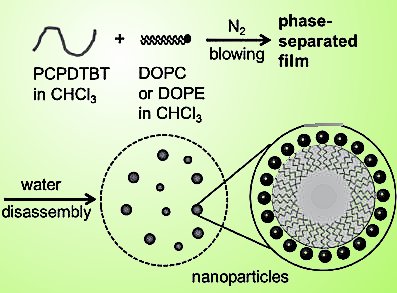Nanoparticles and nanodots of conjugated polymers have received considerable attention to realize brighter luminescence, facile processing, and enhanced device efficiency.
Juhyun Park, Chung-Ang University, Seoul, South Korea, and colleagues developed a method to prepare nanoparticles of conjugated polymers from phase-separated nanoassemblies in films of polymers and phospholipids by breaking the films with ultrasonication in water. This novel approach for preparing nanoparticles/nanodots of conjugated polymers is clearly distinguished from current technologies.
The team prepared phase-separated thin films of poly[ 2,6 -(4,4-bis-(2-ethylhexyl)-4 H -cyclopenta[2,1-b;3,4-b′]-dithiophene)-alt-4,7-(2,1,3-benzothiadiazole]] (PCPDTBT) and a phospholipid, and then broke the thin films to form nanoparticles of conjugated polymers. As shown in the picture, they used 1,2-dioctanoyl-sn-glycero-3-phosphocholine (DOPC) or 1,2-dioctanoyl-sn-glycero-3-phosphoethanolamine (DOPE).
The resulting lipid-assembled nanoparticles of conjugated polymers contain smaller lipid vesicles, and present strong absorption at longer wavelengths. They can thus be used both as fluorescence imaging probes and photothermal therapeutic agents employing near-infrared light.
- Nanoparticles of Conjugated Polymers Prepared from Phase-Separated Films of Phospholipids and Polymers for Biomedical Applications,
Jungju Yoon, Jungheon Kwag, Tae Joo Shin, Joonhyuck Park, Yong Man Lee, Yebin Lee, Jonghyup Park, Jung Heo, Chulmin Joo, Tae Jung Park, Pil J. Yoo, Sungjee Kim, Juhyun Park,
Adv. Mater. 2014.
DOI: 10.1002/adma.201400906




